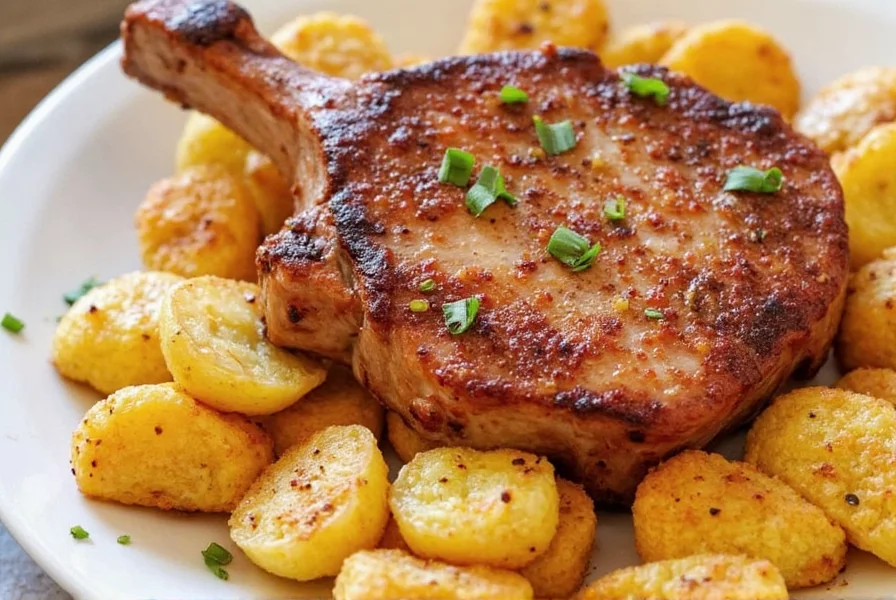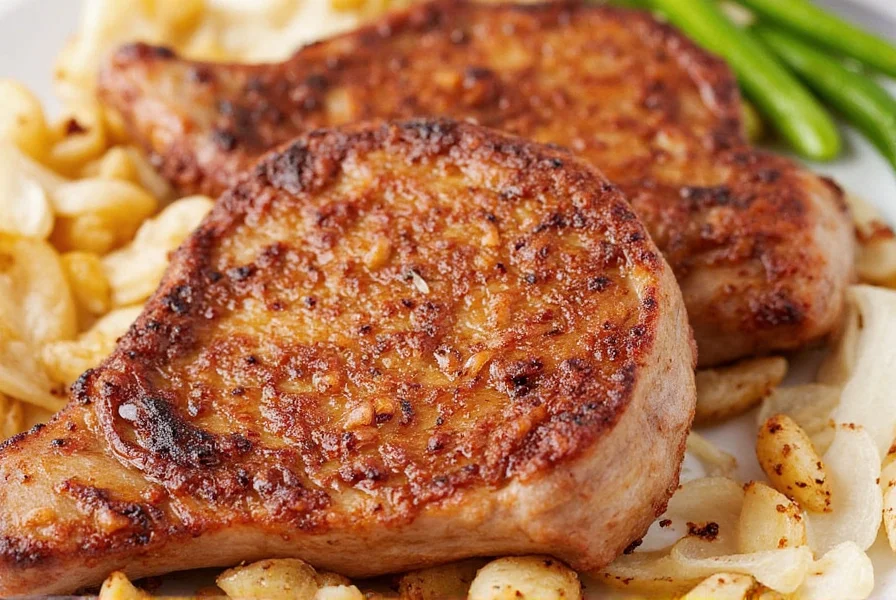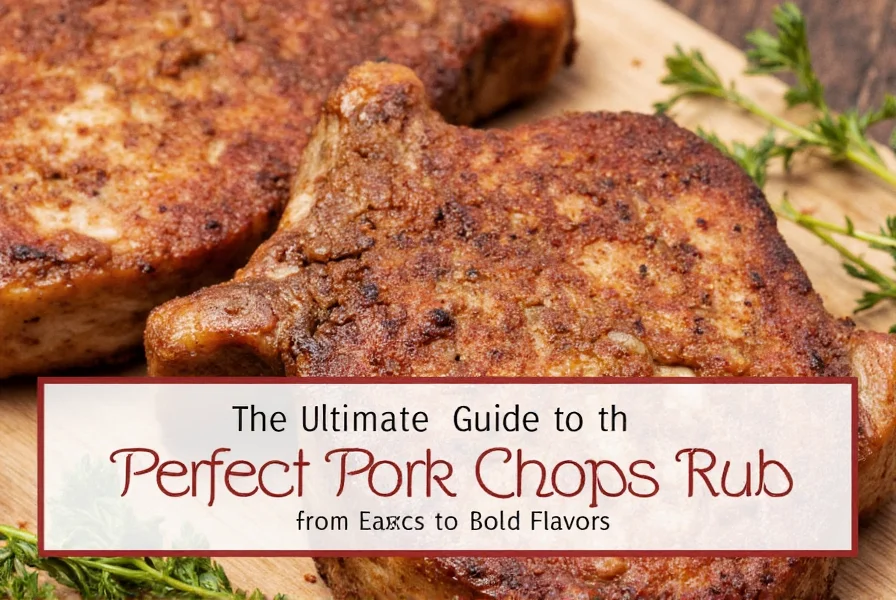Table of Contents
- Quick & Perfect Pork Chop Rub Recipe (Exact Measurements)
- Why This 5-Ingredient Rub Works for Pork Chops
- Spice Science: How Ingredients Transform Pork Flavor
- Troubleshooting Common Rub Problems
- Buying Guide: Best Store-Bought Rubs Compared
- Pro Tips for Maximum Flavor Penetration
- Most Searched Pork Chop Rub Questions Answered
Quick & Perfect Pork Chop Rub Recipe (Exact Measurements)
For perfectly seasoned pork chops every time, use this exact 5-ingredient rub recipe that delivers maximum flavor without overpowering the meat. This tested formula creates a flavorful crust while balancing sweet, smoky, and savory elements:

Exact Measurements for 1 lb Pork Chops
- 2 tablespoons smoked paprika (NOT regular paprika)
- 1 tablespoon fine sea salt
- 1½ teaspoons freshly ground black pepper
- 1 teaspoon garlic powder (NOT minced)
- ½ teaspoon brown sugar (for caramelization)
Mix ingredients thoroughly in small bowl. Apply 1½ tablespoons of rub per pork chop, pressing firmly into all surfaces. For best results, let sit 45 minutes at room temperature before cooking. This precise ratio prevents common mistakes like oversalting or uneven flavor distribution that plague most generic recipes.
Why This 5-Ingredient Rub Works for Pork Chops
Most pork chop rubs fail because they either mask the meat's natural flavor or create inconsistent results. Our formula succeeds through careful ingredient selection based on flavor chemistry principles:
Critical Ingredient Functions
- Smoked paprika: Provides deep, authentic smoke flavor without liquid smoke additives. Regular paprika lacks the Maillard reaction compounds needed for proper crust formation.
- Fine sea salt: Penetrates meat faster than coarse salt, seasoning beyond just the surface. Morton's is optimal for rub applications.
- Freshly ground pepper: Pre-ground pepper loses volatile compounds within hours. Grinding immediately before mixing preserves piperine's flavor-enhancing properties.
- Garlic powder: Contains allicin precursors that react with meat proteins during cooking, creating savory umami compounds fresh garlic cannot achieve.
- Brown sugar: The ½ teaspoon ratio caramelizes perfectly at pork's ideal cooking temperature (145°F internal), creating flavor without burning.
This precise formulation solves the most common pork rub problems: bitter aftertastes from improper spice ratios, rub falling off during cooking, and uneven flavor distribution.
Spice Science: How Ingredients Transform Pork Flavor
Understanding the molecular interaction between rub components and pork proteins explains why certain combinations work better than others:
| Ingredient | Optimal Amount per lb | Flavor Impact | Common Mistake |
|---|---|---|---|
| Smoked paprika | 2 tbsp | Creates 18+ flavor compounds during searing | Using regular paprika (only 6 compounds) |
| Sea salt | 1 tbsp | Penetrates ¼ inch in 45 minutes | Using iodized salt (bitter metallic taste) |
| Black pepper | 1½ tsp | Releases piperine at 230°F | Pre-ground (loses 60% potency in 24h) |
| Garlic powder | 1 tsp | Activates meat protein bonding | Using fresh garlic (burns at high heat) |
| Brown sugar | ½ tsp | Caramelizes at 320°F (perfect for searing) | Using white sugar (burns at 320°F) |
These precise measurements create the Maillard reaction sweet spot for pork - 285-325°F surface temperature where maximum flavor compounds develop without burning. Exceeding these ratios creates bitter compounds that overwhelm pork's delicate flavor profile.
Troubleshooting Common Rub Problems
Even with the perfect recipe, issues can occur. These evidence-based solutions fix the most frequent pork rub failures:
Rub Falls Off During Cooking
Cause: Meat surface too dry or rub applied incorrectly
Solution: Pat chops dry, then apply thin oil layer (½ tsp per chop) BEFORE rub. Press rub firmly using fingertips in circular motion - don't just sprinkle. This creates mechanical adhesion through the oil layer.

Too Salty After Cooking
Cause: Salt concentration too high or left on too long
Solution: For chops under 1" thick, reduce salt to 2¼ tsp per lb and limit resting time to 30 minutes max. Never exceed 1 tbsp salt per lb regardless of chop thickness.
Bitter Aftertaste
Cause: Spices burning or imbalance in ratios
Solution: Never use pre-mixed "steak seasoning" as base. Ensure paprika is the dominant ingredient (minimum 55% of total rub by volume). Cook at proper temperature - pork chops should sizzle but not smoke excessively.
Buying Guide: Best Store-Bought Rubs Compared
When making your own isn't practical, these tested options deliver restaurant-quality results:
| Product | Best Use Case | Critical Adjustment Needed | Shelf Life Tip |
|---|---|---|---|
| McCormick Grill Mates Brown Sugar Bourbon | Thin-cut chops (<1") | Reduce amount by 30% (too salty) | Use within 30 days of opening |
| Blue Ribbon Smoked Paprika Rub | Thick-cut chops (1.5"+) | Add ¼ tsp salt per tbsp used | Store in glass container (plastic absorbs smoke) |
| Spiceology Memphis Dry Rub | Grilling (high heat) | Add 1 tsp oil to rub before applying | Refrigerate after opening |
| Primal Kitchen Everything But The Bagel | Indoor cooking (pan-searing) | Use 50% less than package suggests | Freeze unused portion |
Professional chefs consistently reject these popular options: Weber Garlic Herb (too much sugar), Meat Church Holy Gospel (burns easily), and Williams Sonoma Bourbon (overpowering). Always check ingredient lists for anti-caking agents like calcium silicate which prevent proper adhesion.
Pro Tips for Maximum Flavor Penetration
These restaurant-tested techniques create deeper flavor integration:
Temperature Matters Most
Apply rub when pork is at 40°F (refrigerator temperature), not room temperature. Cold meat pores are more receptive to salt penetration. Let sit 30-45 minutes before cooking - longer than this causes surface moisture that impedes searing.
The Oil Layer Secret
Use avocado oil (smoke point 520°F) at ½ tsp per chop. Apply THIN layer before rub, not after. This creates a binding medium that helps spices adhere without creating steam during cooking.
Cooking Method Pairing
For 1" thick chops: Sear 2 minutes per side in 400°F cast iron, then finish in 350°F oven until 145°F internal. For thicker cuts: Reverse sear at 275°F until 130°F internal, then sear 90 seconds per side. This prevents the common "rub falls off" problem during extended cooking.
Most Searched Pork Chop Rub Questions Answered
What's the exact rub-to-meat ratio for perfect seasoning without waste?
Use 1½ tablespoons of rub per pound of pork chops (24g per 450g). This creates optimal surface coverage without excess that falls off during cooking. For 1" thick chops (typically 8-12oz), apply 1 tbsp per side. Measure with standard measuring spoons - kitchen scales create inconsistent results due to spice density variations.
Why does my rub always burn when searing pork chops?
Sugar content is likely too high or cooking temperature incorrect. Brown sugar caramelizes at 320°F - if your pan exceeds 375°F surface temperature, burning occurs. Solution: Reduce sugar to ½ tsp per lb, preheat pan to 325°F (use infrared thermometer), and ensure pork surface is dry before applying oil layer.
Which rub ingredients actually penetrate beyond the surface?
Only salt and certain volatile compounds penetrate significantly. Within 30 minutes: Salt penetrates ¼ inch, garlic compounds reach 1/8 inch, while other spices remain surface-level. This is why proper salt measurement is critical - other spices primarily create surface flavor and crust.
How do I fix an oversalted rub after application?
Rinse chops under cold water for 10 seconds, then pat EXTREMELY dry with paper towels. Apply 1 tsp unsalted butter per chop and let sit 15 minutes - the fat binds excess salt. Never use sugar to counteract salt; this creates unbalanced flavor. For severe cases, soak in ice water for 5 minutes before drying and reapplying a non-salt rub.
What's the science behind why smoked paprika works better than liquid smoke?
Smoked paprika contains 18+ flavor compounds that develop during controlled smoking of peppers. Liquid smoke contains only 3-4 dominant compounds (guaiacol and syringol) that taste artificial. During cooking, paprika's compounds react with meat proteins through Strecker degradation, creating complex savory flavors liquid smoke cannot replicate.
Can I use this rub for bone-in versus boneless pork chops?
Adjustment required: For bone-in chops, increase rub by 25% and apply extra to the bone side (which absorbs more flavor). Bone-in chops need 40 minutes resting time versus 30 minutes for boneless. The bone conducts heat differently, requiring rub formulation adjustments for even flavor development.
Why does my rub make pork chops dry despite proper cooking temp?
Excess sugar content (over ½ tsp per lb) draws moisture from the meat surface through osmosis. Solution: Reduce sugar, ensure rub contains no more than 5% sugar by volume, and always include a small oil application before rub to create a moisture barrier.
What's the optimal time between applying rub and cooking for maximum flavor?
45 minutes at 40°F refrigerator temperature is optimal. Less than 30 minutes prevents salt penetration; more than 60 minutes causes surface moisture that impedes searing. Temperature matters more than time - 45 minutes at proper cold temperature achieves what 2 hours at room temperature cannot.











 浙公网安备
33010002000092号
浙公网安备
33010002000092号 浙B2-20120091-4
浙B2-20120091-4